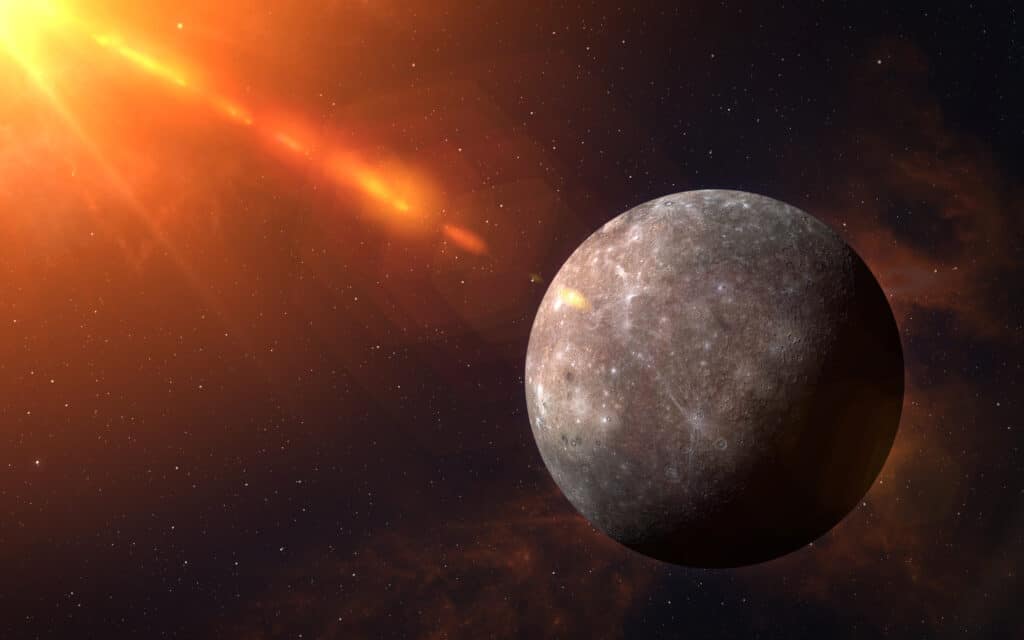Introduction
Mercury is the smallest planet in the entire solar system, with a diameter only 40 percent larger than Earth’s moon. It is also the closest planet to the Sun. This makes the light seven times brighter on Mercury’s surface than on Earth’s. The planet has no moons and has the fastest orbit around the Sun out of any other planet. It completes a full orbit every 88 days. Here is a look at what the planet is made of and the possible presence of water so close to the Sun.
Mercury’s Surface
The surface of the planet is riddled with craters and other indentations as a result of comets and meteoroids crashing into it over billions of years. Mercury‘s atmosphere is composed of oxygen, sodium, hydrogen, helium, and potassium and is incredibly thin. This atmosphere does not offer much defense from celestial objects. That is why the surface of the planet is so textured and rugged. The entire planet is greyish-brown, with brighter streaks forming when asteroids and comets collide with the surface. When this collision occurs, fine particles can be distributed far from the crater itself. As a result, they reflect sunlight more brightly than larger pieces of rock. We know these streaks crater rays.
The planet also has extremely volatile temperatures. They range from negative 290 degrees Fahrenheit (negative 180 degrees Celsius) at night to 800 degrees Fahrenheit (430 degrees Celsius) in times of close proximity to the Sun. Due to the planet’s magnetic field, Mercury also has a very active surface. While there is no confirmed life on Mercury, its magnetic field interacts with solar winds to create powerful magnetic tornadoes. This causes hot solar wind plasma to clash with the planet’s surface and kick up neutrally charged atoms into the atmosphere.

Mercury is greyish-brown, with brighter streaks forming when asteroids and comets collide with the surface.
©iStock.com/buradaki
What Is Mercury Made Of?
Three-quarters of Mercury’s diameter is taken up by its huge iron core. This core is roughly the size of Earth’s moon. It acts as a heat source for the outer layers of the planet. It also contributes to the planet’s magnetic field and gravitational pull. The planet’s core has a radius of around 1,200 miles (1,900 kilometers) and has more iron than any other planet in the solar system. Most of the iron in the core is molten rather than solid. The core is surrounded by a rocky shell that is around 350 miles (550 kilometers) thick. This crust is predominately made up of silicate rocks and metals, which give the planet its grayish-brown color.
Is There Water on Mercury?
Yes, there is water on Mercury in the form of ice. In 2011, the MESSENGER, a robotic space probe, was sent to Mercury to orbit the planet and gather more information about its surface and its chemical composition. A few years later, the probe was able to identify deposits in many of the shadowy regions of craters near the planet’s poles that were confirmed to be water ice. The surface of Mercury can reach extremely hot temperatures far past water’s melting and boiling points. However, the shadows have allowed the ice to remain shielded from the heat of the Sun and solar tornadoes on the surface, allowing for the continuous presence of water on the planet. NASA estimates that there are at least 100,000,000,000 tons of ice on Mercury.
The photo featured at the top of this post is © NASA images/Shutterstock.com
Thank you for reading! Have some feedback for us? Contact the AZ Animals editorial team.






